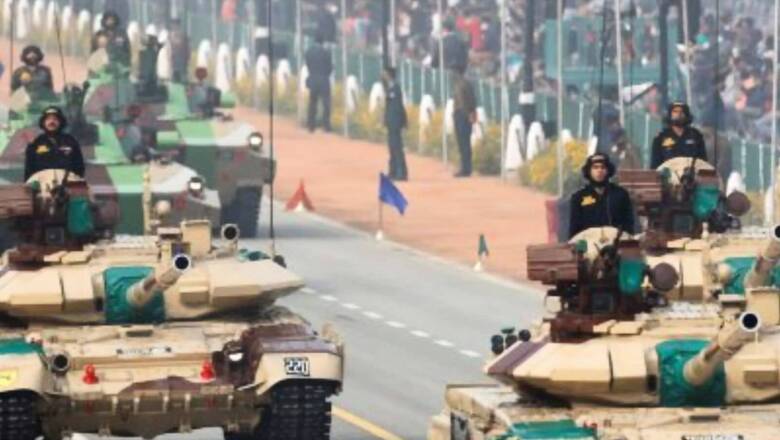
views
National security is so closely linked to economy that a country cannot sustain continued expenditure on defence unless it is backed by a vibrant economy. The erstwhile USSR broke up while trying to match its defence spending with the Western powers led by the USA during the Cold War because the Soviet economy could not sustain disproportionate spending on defence. Therefore, the defence budget is of utmost importance to not only the defence forces but all citizens of the country. As the size of the Indian economy grows, even a small percentage of that economy would be adequate to finance the defence modernisation. By the same analogy, in case the economic growth is stunted, the same amount of defence spending would account for a very high proportion of government spending.
Geopolitically, India lies in a volatile and adversarial neighbourhood which necessitates a substantial annual budget to maintain and equip the armed forces to meet external and internal security challenges. Allocation for defence is a necessity akin to paying annual insurance policy premium for security of the country, but at the same time it needs to be understood that the defence budget often comes at the cost of developmental needs of the citizens.
Government makes an endeavour to balance the budget earmarked for development and defence. Keeping these parameters in mind, Finance Minister Nirmala Sitharaman in her Budget speech on February 1, 2022 has allocated Rs 1.52 trillion for defence for the next financial year. It goes to the credit of the government that the while the capital allocation has increased by 13 per cent, the allocation for pension and revenue has been kept stable.
Another aspect which the Budget has aimed to address is import dependence. Though India’s import of weapons has dropped 33 per cent during the period 2016-2020 compared to the previous five years, India remains the second largest importer of arms after Saudi Arabia. The country cannot afford to continue with the tag of high import dependence while sharing borders with two nuclear-armed and conniving adversaries.
To arrest the trend of import dependence, last year, the government had promulgated a negative import list which implied that 58 per cent of the Budget had to be utilised to procure equipment from domestic sources. This restriction has now been increased to 68 per cent of the capital procurement budget. While reduction in import dependence is a welcome step, however, quality and capabilities of weapons platforms procured to equip the armed forces cannot be compromised to attain self-reliance or ‘Atmanirbharta’.
India having neglected her defence industry for decades cannot overnight beat the learning curve of technological advancement, especially when technologies are becoming obsolete even before they are fully absorbed. Synergy between the public and private sectors and collaboration with global entities possessing latest technologies may be a more pragmatic approach to attain self-reliance. Reorganising Ordnance Factory Board (OFB) into Public Sector Units (PSUs) is a welcome step, but a lot more needs to be done to make them efficient and accountable.
India now takes prides in being home to world-class private industry which is capable of manufacturing even the most sensitive and technologically advanced equipment, probably with foreign collaboration and technology sharing, hence, they must be given an opportunity and provided a level-playing field to deliver the national defence needs.
Provision in the Budget to assist private sector in research and development and collaboration with Defence Research and Development Organisation (DRDO) has the potential to transform defence production, provided bureaucratic processes do not make this proposal a nonstarter because government organisations are invariably risk-averse and would like to arrive at a very conservative agreement with the private players. Innovative ideas and out-of-the-box thinking is a prerequisite to get meaningful outcome from such a collaboration. We must create a win-win situation for all stakeholders. Remember, business houses opt to collaborate with the government to do ‘business’ and not ‘social service’.
Unutilised capital budget by the three services is an impediment to optimum utilisation of the funds. During the last financial year, Army, Navy and Indian Air Force could utilize only 40, 90 and 70 per cent of their allocated capital budget, respectively. Besides frequent change of service officers in key appointments dealing with capital procurement, bureaucratic delays by repeatedly raising frivolous observations are some of the major causes of underutilisation of the budget. To obviate this problem, provision to carry forward the capital budget to the next year must be incorporated in defence procurement manuals as well as ensuring accountability for the delays.
The way forward is to achieve the right balance between allocation for defence and development. First, Indian economy must grow to a size where 2 to 3 per cent of the GDP earmarked for defence translates into adequate numbers to fund the defence budget without adversely impacting development. Second, long-term steps must be taken to encourage domestic industry to innovate and produce world-class defence equipment for the armed forces and export. This would result in true self-reliance. Third, jointmanship between the three services is necessary to arrive at objective prioritisation without inter-service rivalry coming in the way for optimum utilisation of the meagre budget. Fourth, defence PSUs and DRDO must be held accountable for any delays and cost overruns and be treated on par with the private industry to make them efficient and also ensure armed forces get the desired value for the money spent.
Economic security is a pre-requisite for fool-proof national security. A visionary defence budget catering to address the long-term challenges to India’s security is a necessity. This vision must translate into India becoming a self-reliant and confident country capable of retaining strategic independence. The policy makers must make these principles as cornerstones of national security framework.
The author was head of Army Service Corps. He is a distinguished fellow at United Service Institution of India and a motivational and leadership speaker. The views expressed in this article are those of the author and do not represent the stand of this publication.
Read all the Latest Opinions here



















Comments
0 comment